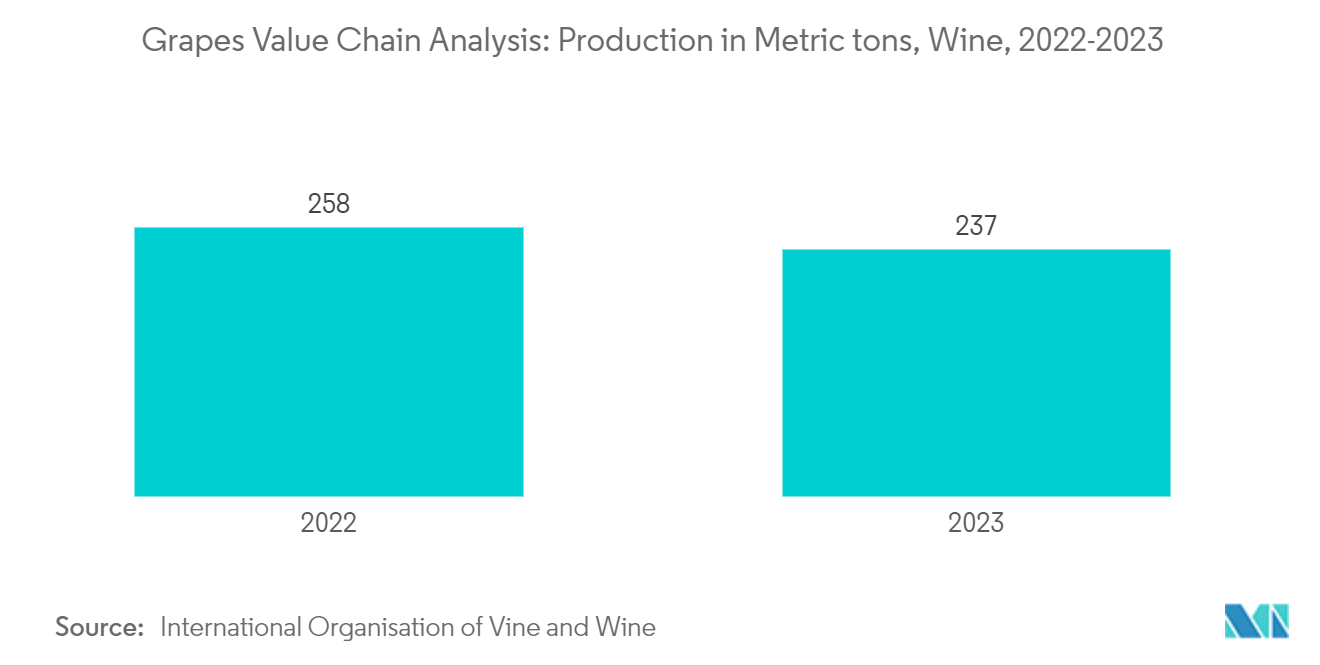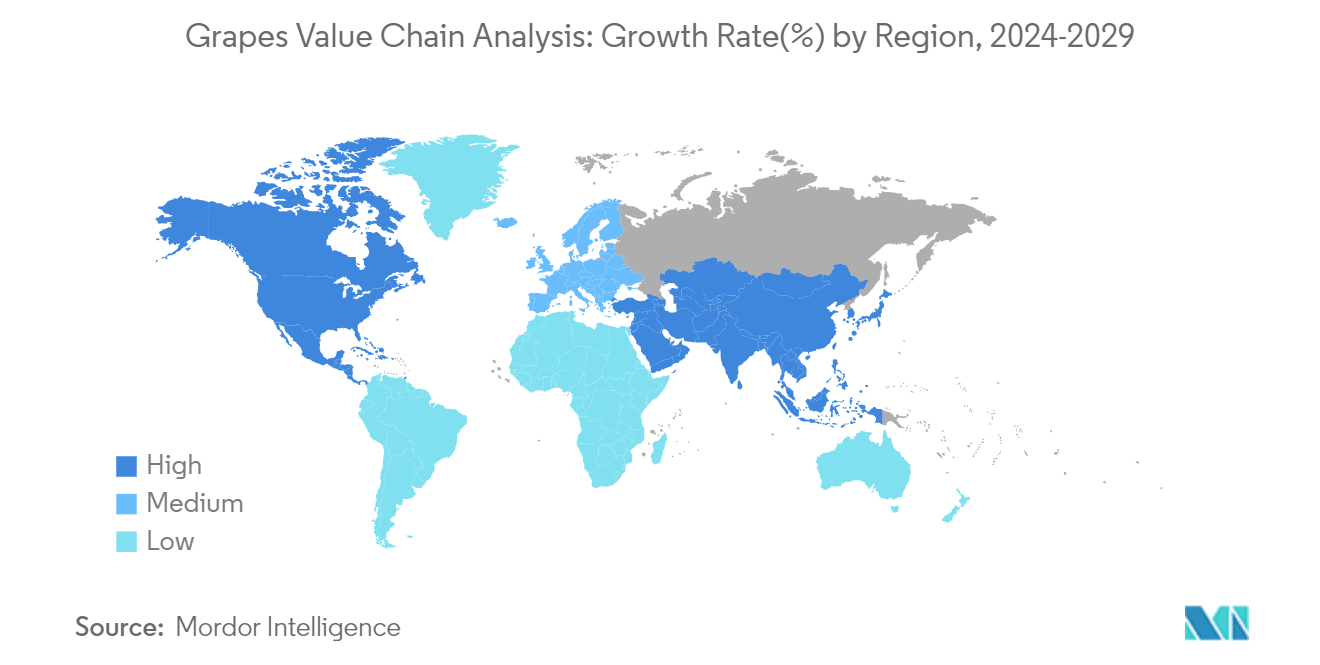
Grapes Value Chain Market Analysis
The Grapes Market size is estimated at USD 283.28 billion in 2025, and is expected to reach USD 322.07 billion by 2030, at a CAGR of 2.6% during the forecast period (2025-2030).
- Grapes rank among the world's largest fruit crops, cultivated over an estimated 6.7 million hectares globally. The United States Department of Agriculture’s Foreign Agricultural Service projects the global production of fresh table grapes for the 2023/24 season to reach 28.1 million metric tons. This optimistic projection is supported by favorable growing conditions in India and China, offsetting weather-related challenges faced by the European Union, Turkey, and the United States. Globally, the two predominant types of grapes cultivated are table grapes and wine grapes, with table grapes being primarily intended for fresh consumption.
- Farmers are the key players in the grape value chain, directly engaged in grape production. This group encompasses individual farmers and entrepreneurs who not only cultivate grapes using diverse farming techniques but also partake in processing activities, including post-harvest handling, marketing, and distribution. Numerous farmers' associations exist across various grape-producing nations. Notably, the International Viticulture and Enology Society (IVES) and the International Organization of Vine and Wine are instrumental in the grape supply chain.
- Importers and exporters are pivotal to the global grape value chain. Leading the charge in exports are countries from Latin America and Europe, with Chile, Peru, Italy, and the Netherlands at the forefront. Additionally, Asian and African nations, especially China, India, and South Africa, make notable contributions. These nations boast a robust network of export traders, essential to the value chain, who source grapes directly from local farmers or organizations. Key importing nations encompass the United States, Germany, Canada, and the United Kingdom, among others.
- Key players in the global grapes market include wholesalers such as Exim Trading Global, Beva Fruits International (BFI), and More Than Grapes. These wholesalers leverage global sourcing and logistics networks to distribute grapes in high-demand markets, all while ensuring compliance with USDA and EU organic standards. Major retailers, including retail giants like Carrefour, Walmart, and Tesco, are among the primary buyers of these grapes.
Grapes Value Chain Analysis Market Trends
Decrease in Wine Production
- In 2023, the world's vineyard surface area shrank by 0.5% from the previous year, totaling 7.2 million hectares. This marks the third consecutive year of decline, primarily driven by vineyard removals in major vine-growing regions across both hemispheres. In addition to vine removals, extreme climatic conditions and widespread fungal diseases took a toll on vineyards globally. These challenges culminated in a historically low global wine production of 237 million hectolitres.
- According to the International Organisation of Vine and Wine, the global wine consumption for 2023 was observed at 221 million hectolitres, down 2.6% from 2022's already subdued figures. Inflationary pressures have spiked production and distribution costs, resulting in higher wine prices. This price increase comes at a time when consumers are grappling with reduced purchasing power. Additionally, consumer behavior is being shaped by factors like moderating alcohol consumption, heightened health concerns, and a shift toward premium products. Furthermore, as cannabis and THC consumption gain traction in major global economies, spending is increasingly shifting away from alcohol, prompting consumers to lower their wine purchases.
- As trends in the wine industry shift, enthusiasts are gravitating towards new choices, particularly wines with minimal additives and an emphasis on terroir. With a growing knowledge base, consumers are prioritizing quality, transparency, and ethical production in their selections. The natural wines market is witnessing steady growth, driven by a heightened consumer consciousness about food and drink choices, and a preference for environmentally friendly and sustainable products.

China Leads Global Grape Production
- China dominates the production of grapes in the world. China produced approximately 13.5 million metric tons of grapes and remained the largest grape-producing country in Asia-Pacific and the world in 2023, comprising approximately 48% of the total volume of grapes produced around the globe in 2023. Kyoho and Red Globe are the two most cultivated varieties, accounting for over 50% of the total planted area, though their share is declining. Traditional varieties like Muscat and Summer Black maintain a stable presence, while seedless varieties, including Flame Seedless and Crimson Seedless, show steady growth.
- In recent years, advancements in grape breeding, cultivation, and management technologies have led to the expansion of grape plantations across nearly all provinces in China. Notably, provinces like Hunan, Jiangsu, Zhejiang, and Guangxi have seen rapid growth in acreage. Yunnan province stands out with its exceptionally swift development.
- To enhance both the quantity and quality of their produce, grape farmers are increasingly adopting advanced production facilities and technologies in the country. About one-third of grapes are cultivated using protected horticultural methods, such as greenhouses, plastic insulation sheds, and rain shelters, and they anticipate further expansion of this trend. Due to the integration of protected horticultural methods, innovative breeding technologies, and enhanced storage capabilities, the supply season for domestically produced grapes has been notably extended in the country.

Grapes Value Chain Analysis Market News
- July 2024: In a bid to uplift grape growers, Tamil Nadu Agricultural University (TNAU) in India has rolled out high-yielding, export-oriented colored grape varieties. These varieties, introduced under both open and protected cultivation, include Jyoti seedless, Krishna seedless, Saritha seedless, A-18, Manjari Medika, Red Globe, and Sharad seedless.
- June 2024: Divine Flavor, a grape grower-shipper, has teamed up with Niabell Farms to introduce California table grapes to their offerings for the first time, starting July 2024. By expanding into Bakersfield, CA, they aim to seamlessly connect the conclusion of the Mexican grape season with the onset of South American imports. This strategic move is pivotal for ensuring Divine Flavor's consistent year-round supply of premium table grapes.
- June 2024: Sun World International, a breeder and licensor based in California, introduced two new table grape varieties: Sugrafiftyfour and Sugrafiftysix. The Sugrafiftyfour variety boasts a tropical fruity flavor, while Sugrafiftysix is distinguished by its crunchy texture and sweet juiciness. Both are mid-season green seedless varieties.
- May 2024: ProducePay, an agtech company, has partnered with Four Star Fruit BB, one of the world's largest growers and shippers of table grapes, along with prominent Mexican growers, to deliver four million cases of table grapes in 2024.
Grapes Value Chain Analysis Industry Segmentation
A grape is a fruit, botanically a berry, of the deciduous woody vines of the flowering plant genus Vitis. Grapes are a non-climacteric type of fruit, generally occurring in clusters.
The Grapes Value Chain Analysis Market Report offers an Overview, Price Markups, Stakeholders, and Issues and Challenges of the value chain and supply chain of Grapes.
Grapes Value Chain Analysis Market Research FAQs
How big is the Grapes Market?
The Grapes Market size is expected to reach USD 283.28 billion in 2025 and grow at a CAGR of 2.60% to reach USD 322.07 billion by 2030.
What is the current Grapes Market size?
In 2025, the Grapes Market size is expected to reach USD 283.28 billion.
Which is the fastest growing region in Grapes Market?
Asia-Pacific is estimated to grow at the highest CAGR over the forecast period (2025-2030).
Which region has the biggest share in Grapes Market?
In 2025, the Asia-Pacific accounts for the largest market share in Grapes Market.
What years does this Grapes Market cover, and what was the market size in 2024?
In 2024, the Grapes Market size was estimated at USD 275.91 billion. The report covers the Grapes Market historical market size for years: 2019, 2020, 2021, 2022, 2023 and 2024. The report also forecasts the Grapes Market size for years: 2025, 2026, 2027, 2028, 2029 and 2030.
Our Best Selling Reports
Grapes Value Chain Analysis Industry Report
Statistics for the 2025 Grapes Value Chain Analysis market share, size and revenue growth rate, created by Mordor Intelligence™ Industry Reports. Grapes Value Chain Analysis analysis includes a market forecast outlook for 2025 to 2030 and historical overview. Get a sample of this industry analysis as a free report PDF download.


